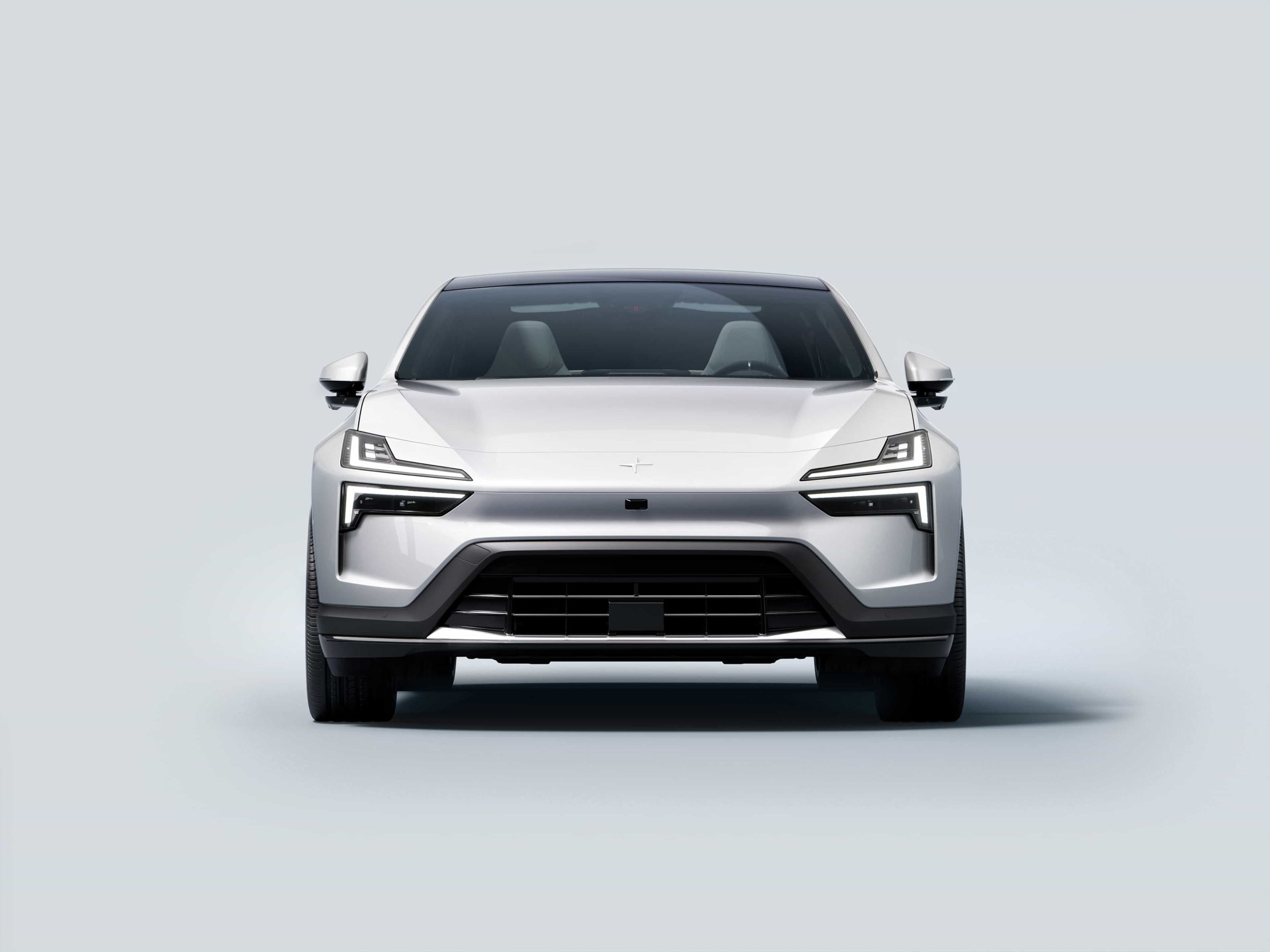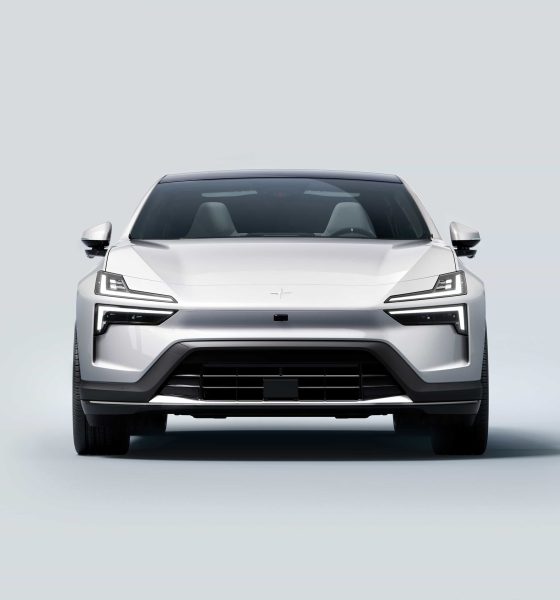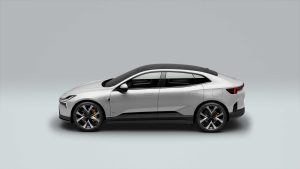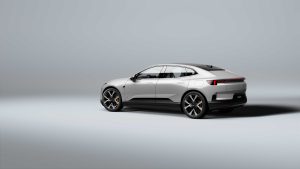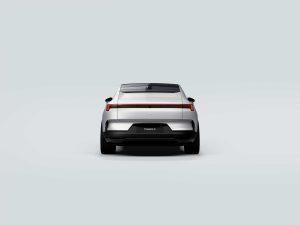Polestar has unveiled the fastest production vehicle it has ever made, the Polestar 4 SUV Coupe.
The SUV Coupe segment is easily one of the most unique on the market. While sleeker than a traditional SUV offering, these vehicles retain the higher ground clearance of their SUV siblings and often come with a laundry list of quirks. That is precisely the case with Polestar’s newest offering, the Polestar 4 SUV Coupe.
As stated above, the Polestar 4 retains the ground clearance of its Polestar 3 full-size SUV cousin. Still, its profile is more similar to its Polestar 2 sedan and Precept Concept vehicle siblings. Moreover, in following the trend of the segment, the Polestar 4 is chock-full of design quirkiness.
As noted by many an automotive journalist, the Polestar 4 lacks a rear window, instead opting for a system of cameras that provide the driver a complete view around the vehicle. Further, looking at the vehicle’s side, it has some of the most aggressively carved door panels on the market, second only to the Ford Mustang Mach-E, which has famously used the aggressive angularity between the wheels to “visually slim” the vehicle.
“With Polestar 4, we have taken a fundamental new approach to SUV coupé design,” says Thomas Ingenlath, Polestar CEO. “Rather than simply modifying an existing SUV, giving it a faster roofline and, as a result, compromising elements like rear headroom and comfort, we have designed Polestar 4 from the ground up as a new breed of SUV coupé that celebrates rear occupant comfort and experience.”
Moving on from Polestar’s intriguing design language, the Swedish automaker’s offering packs an impressive set of specs, backing the company’s statement; “our fastest production vehicle to date.” The Polestar 4 will be available in either dual-motor all-wheel-drive or single-motor rear-wheel-drive, and with its top trim (dual-motor), the SUV Coupe will rocket to 60mph in just 3.8 seconds. This rapid acceleration is made possible by 544 horsepower and 506 pound-feet of torque.
For those looking for the more tame single-motor option, the Polestar 4 provides an ample 272 horsepower and 253 pound-feet of torque.
Doubling down on its performance chops, the dual-motor equipped high-performance variant also comes with a “semi-active” suspension system, allowing the driver to tweak settings between performance and comfort.
The final option that buyers will choose from is between standard range or long range battery sizes. With the massive 102kWh battery, drivers can expect a max range of 335 miles with the dual motor variant or 373 miles with the single motor. Polestar has not yet released specifications for its standard range version but is expected to do so shortly, ahead ovehicle’sicle’s production launch in China.
The Polestar 4 will first be available in China during the fourth quarter of this year, while the rest of the world will need to wait until the first half of 2024. Polestar is beginning production of the vehicle in China but expects to expand production to other locations as it expands the regions it will sell in.
Besides the eye-watering performance metricsvehicle’sicle’s price may be the most surprising specification announced by Polestar today. Starting at $60,000 when it finally makes its way to the United States, or 60,000 Euros when it eventually becomes available across the pond, the Polestar 4 is quite aggressively priced, putting it essentially in line with the higher performance Tesla Model Y, Ford Mustang Mach-E, and significantly below larger offerings such as Polestar’s own 3 (full-size SUV), the Tesla Model X, or Rivian R1S.
What do you think of the article? Do you have any comments, questions, or concerns? Shoot me an email at william@teslarati.com. You can also reach me on Twitter @WilliamWritin. If you have news tips, email us at tips@teslarati.com!

Elon Musk
Starlink passes 9 million active customers just weeks after hitting 8 million
The milestone highlights the accelerating growth of Starlink, which has now been adding over 20,000 new users per day.

SpaceX’s Starlink satellite internet service has continued its rapid global expansion, surpassing 9 million active customers just weeks after crossing the 8 million mark.
The milestone highlights the accelerating growth of Starlink, which has now been adding over 20,000 new users per day.
9 million customers
In a post on X, SpaceX stated that Starlink now serves over 9 million active users across 155 countries, territories, and markets. The company reached 8 million customers in early November, meaning it added roughly 1 million subscribers in under seven weeks, or about 21,275 new users on average per day.
“Starlink is connecting more than 9M active customers with high-speed internet across 155 countries, territories, and many other markets,” Starlink wrote in a post on its official X account. SpaceX President Gwynne Shotwell also celebrated the milestone on X. “A huge thank you to all of our customers and congrats to the Starlink team for such an incredible product,” she wrote.
That growth rate reflects both rising demand for broadband in underserved regions and Starlink’s expanding satellite constellation, which now includes more than 9,000 low-Earth-orbit satellites designed to deliver high-speed, low-latency internet worldwide.
Starlink’s momentum
Starlink’s momentum has been building up. SpaceX reported 4.6 million Starlink customers in December 2024, followed by 7 million by August 2025, and 8 million customers in November. Independent data also suggests Starlink usage is rising sharply, with Cloudflare reporting that global web traffic from Starlink users more than doubled in 2025, as noted in an Insider report.
Starlink’s momentum is increasingly tied to SpaceX’s broader financial outlook. Elon Musk has said the satellite network is “by far” the company’s largest revenue driver, and reports suggest SpaceX may be positioning itself for an initial public offering as soon as next year, with valuations estimated as high as $1.5 trillion. Musk has also suggested in the past that Starlink could have its own IPO in the future.
News
NVIDIA Director of Robotics: Tesla FSD v14 is the first AI to pass the “Physical Turing Test”
After testing FSD v14, Fan stated that his experience with FSD felt magical at first, but it soon started to feel like a routine.

NVIDIA Director of Robotics Jim Fan has praised Tesla’s Full Self-Driving (Supervised) v14 as the first AI to pass what he described as a “Physical Turing Test.”
After testing FSD v14, Fan stated that his experience with FSD felt magical at first, but it soon started to feel like a routine. And just like smartphones today, removing it now would “actively hurt.”
Jim Fan’s hands-on FSD v14 impressions
Fan, a leading researcher in embodied AI who is currently solving Physical AI at NVIDIA and spearheading the company’s Project GR00T initiative, noted that he actually was late to the Tesla game. He was, however, one of the first to try out FSD v14.
“I was very late to own a Tesla but among the earliest to try out FSD v14. It’s perhaps the first time I experience an AI that passes the Physical Turing Test: after a long day at work, you press a button, lay back, and couldn’t tell if a neural net or a human drove you home,” Fan wrote in a post on X.
Fan added: “Despite knowing exactly how robot learning works, I still find it magical watching the steering wheel turn by itself. First it feels surreal, next it becomes routine. Then, like the smartphone, taking it away actively hurts. This is how humanity gets rewired and glued to god-like technologies.”
The Physical Turing Test
The original Turing Test was conceived by Alan Turing in 1950, and it was aimed at determining if a machine could exhibit behavior that is equivalent to or indistinguishable from a human. By focusing on text-based conversations, the original Turing Test set a high bar for natural language processing and machine learning.
This test has been passed by today’s large language models. However, the capability to converse in a humanlike manner is a completely different challenge from performing real-world problem-solving or physical interactions. Thus, Fan introduced the Physical Turing Test, which challenges AI systems to demonstrate intelligence through physical actions.
Based on Fan’s comments, Tesla has demonstrated these intelligent physical actions with FSD v14. Elon Musk agreed with the NVIDIA executive, stating in a post on X that with FSD v14, “you can sense the sentience maturing.” Musk also praised Tesla AI, calling it the best “real-world AI” today.
News
Tesla AI team burns the Christmas midnight oil by releasing FSD v14.2.2.1
The update was released just a day after FSD v14.2.2 started rolling out to customers.

Tesla is burning the midnight oil this Christmas, with the Tesla AI team quietly rolling out Full Self-Driving (Supervised) v14.2.2.1 just a day after FSD v14.2.2 started rolling out to customers.
Tesla owner shares insights on FSD v14.2.2.1
Longtime Tesla owner and FSD tester @BLKMDL3 shared some insights following several drives with FSD v14.2.2.1 in rainy Los Angeles conditions with standing water and faded lane lines. He reported zero steering hesitation or stutter, confident lane changes, and maneuvers executed with precision that evoked the performance of Tesla’s driverless Robotaxis in Austin.
Parking performance impressed, with most spots nailed perfectly, including tight, sharp turns, in single attempts without shaky steering. One minor offset happened only due to another vehicle that was parked over the line, which FSD accommodated by a few extra inches. In rain that typically erases road markings, FSD visualized lanes and turn lines better than humans, positioning itself flawlessly when entering new streets as well.
“Took it up a dark, wet, and twisty canyon road up and down the hill tonight and it went very well as to be expected. Stayed centered in the lane, kept speed well and gives a confidence inspiring steering feel where it handles these curvy roads better than the majority of human drivers,” the Tesla owner wrote in a post on X.
Tesla’s FSD v14.2.2 update
Just a day before FSD v14.2.2.1’s release, Tesla rolled out FSD v14.2.2, which was focused on smoother real-world performance, better obstacle awareness, and precise end-of-trip routing. According to the update’s release notes, FSD v14.2.2 upgrades the vision encoder neural network with higher resolution features, enhancing detection of emergency vehicles, road obstacles, and human gestures.
New Arrival Options also allowed users to select preferred drop-off styles, such as Parking Lot, Street, Driveway, Parking Garage, or Curbside, with the navigation pin automatically adjusting to the ideal spot. Other refinements include pulling over for emergency vehicles, real-time vision-based detours for blocked roads, improved gate and debris handling, and Speed Profiles for customized driving styles.
